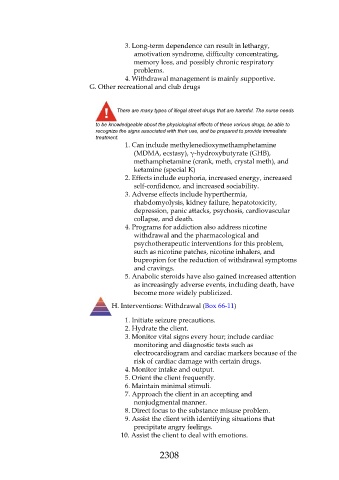Page 2308 - Saunders Comprehensive Review For NCLEX-RN
P. 2308
3. Long-term dependence can result in lethargy,
amotivation syndrome, difficulty concentrating,
memory loss, and possibly chronic respiratory
problems.
4. Withdrawal management is mainly supportive.
G. Other recreational and club drugs
There are many types of illegal street drugs that are harmful. The nurse needs
to be knowledgeable about the physiological effects of these various drugs, be able to
recognize the signs associated with their use, and be prepared to provide immediate
treatment.
1. Can include methylenedioxymethamphetamine
(MDMA, ecstasy), γ-hydroxybutyrate (GHB),
methamphetamine (crank, meth, crystal meth), and
ketamine (special K)
2. Effects include euphoria, increased energy, increased
self-confidence, and increased sociability.
3. Adverse effects include hyperthermia,
rhabdomyolysis, kidney failure, hepatotoxicity,
depression, panic attacks, psychosis, cardiovascular
collapse, and death.
4. Programs for addiction also address nicotine
withdrawal and the pharmacological and
psychotherapeutic interventions for this problem,
such as nicotine patches, nicotine inhalers, and
bupropion for the reduction of withdrawal symptoms
and cravings.
5. Anabolic steroids have also gained increased attention
as increasingly adverse events, including death, have
become more widely publicized.
H. Interventions: Withdrawal (Box 66-11)
1. Initiate seizure precautions.
2. Hydrate the client.
3. Monitor vital signs every hour; include cardiac
monitoring and diagnostic tests such as
electrocardiogram and cardiac markers because of the
risk of cardiac damage with certain drugs.
4. Monitor intake and output.
5. Orient the client frequently.
6. Maintain minimal stimuli.
7. Approach the client in an accepting and
nonjudgmental manner.
8. Direct focus to the substance misuse problem.
9. Assist the client with identifying situations that
precipitate angry feelings.
10. Assist the client to deal with emotions.
2308

